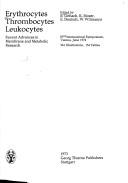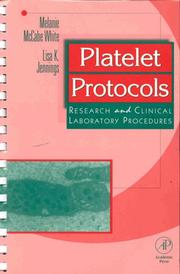| Listing 1 - 10 of 15 | << page >> |
Sort by
|
Book
ISBN: 9535170295 9535107534 Year: 2012 Publisher: IntechOpen
Abstract | Keywords | Export | Availability | Bookmark
 Loading...
Loading...Choose an application
- Reference Manager
- EndNote
- RefWorks (Direct export to RefWorks)
The editor has incorporated scientific contributions from a diverse group of leading researchers in the field of hematology and related blood cell research. This book aims to provide an overview of current knowledge pertaining to our understanding of hematology. The main subject areas will include blood cell morphology and function, the pathophysiology and genetics of hematological disorders and malignancies, blood testing and typing, and the processes governing hematopoiesis. Blood cell physiology, biochemistry and blood flow are covered in this book. This text is designed for hematologists, pathologists and laboratory staff in training and in practice. The work presented in this book will be of benefit to medical students and to researchers of hematology and blood flow in the microcirculation.This book is written primarily for those who have some knowledge of chemistry, biochemistry and general hematology. The authors of each section bring a strong clinical emphasis to the book.
Blood cells. --- Blood --- Blood corpuscles --- Corpuscles, Blood --- Haemocytes --- Hemic cells --- Hemocytes --- Cells --- Corpuscles and platelets --- Haematology
Book
ISBN: 3319073958 331907394X Year: 2014 Publisher: Cham : Springer International Publishing : Imprint: Springer,
Abstract | Keywords | Export | Availability | Bookmark
 Loading...
Loading...Choose an application
- Reference Manager
- EndNote
- RefWorks (Direct export to RefWorks)
Insights into the regulation of immune cell lineage differentiation and specification as well as into the control of lineage integrity, stability and plasticity are of fundamental importance to understanding innate and adaptive immune responses. In this volume, leading experts provide an up-to-date and comprehensive overview of recent advances in the transcriptional control mechanisms and transcription factor networks that regulate these processes in a variety of different immune cell lineages. The chapters cover the regulation of T versus B cell lineage choice, discuss early B cell development and pre-B cell leukemia prevention, address transcriptional control mechanisms during Th differentiation, in regulatory T cells and iNKT cells, detail genomic switches in helper cell fate choice and plasticity, and highlight the role of the BTB-zinc finger family of transcription factors in T cells. Moreover, the chapters discuss transcriptional networks in DCs, NK cells and in innate lymphoid cells. Together, the reviews illustrate key transcriptional control mechanisms that regulate the development and function of immune cells and demonstrate the impressive advances made over the last decade.
Blood cells. --- Blood --- Blood corpuscles --- Corpuscles, Blood --- Haemocytes --- Hemic cells --- Hemocytes --- Cells --- Corpuscles and platelets --- Immunology. --- Immunobiology --- Life sciences --- Serology
Book
ISBN: 1634847954 9781634847957 1634847814 9781634847810 Year: 2016 Publisher: New York
Abstract | Keywords | Export | Availability | Bookmark
 Loading...
Loading...Choose an application
- Reference Manager
- EndNote
- RefWorks (Direct export to RefWorks)
Leukemia. --- Blood cells. --- Blood --- Blood corpuscles --- Corpuscles, Blood --- Haemocytes --- Hemic cells --- Hemocytes --- Cells --- Leucaemia --- Leucemia --- Leucocythaemia --- Leucocythemia --- Leucosis --- Leukaemia --- Leukosis --- Anemia --- Cancer --- Leucocytosis --- Preleukemia --- Corpuscles and platelets
Book
ISBN: 967440273X 9789674402730 Year: 2016 Publisher: [Place of publication not identified], Universiti Sains Islam Malaysia
Abstract | Keywords | Export | Availability | Bookmark
 Loading...
Loading...Choose an application
- Reference Manager
- EndNote
- RefWorks (Direct export to RefWorks)
Blood transfusion.
Blood cells. --- Blood. --- Body fluids --- Fear of blood --- Blood --- Blood corpuscles --- Corpuscles, Blood --- Haemocytes --- Hemic cells --- Hemocytes --- Cells --- Corpuscles and platelets

ISBN: 3134979012 9783134979015 Year: 1973 Publisher: Stuttgart Thieme
Abstract | Keywords | Export | Availability | Bookmark
 Loading...
Loading...Choose an application
- Reference Manager
- EndNote
- RefWorks (Direct export to RefWorks)
Animal biochemistry --- Pathological haematology --- Zoohistology. Zoocytology --- Blood cells --- Blood --- Congresses --- Diseases --- Body fluids --- Fear of blood --- Blood corpuscles --- Corpuscles, Blood --- Haemocytes --- Hemic cells --- Hemocytes --- Cells --- Congresses. --- Corpuscles and platelets --- Diseases&delete& --- Blood cells - Congresses --- Blood - Diseases - Congresses
Book
ISBN: 012802013X 0128019751 9780128020135 9780128019757 Year: 2016 Publisher: Amsterdam Elsevier
Abstract | Keywords | Export | Availability | Bookmark
 Loading...
Loading...Choose an application
- Reference Manager
- EndNote
- RefWorks (Direct export to RefWorks)
Immune system. --- Hematopoiesis. --- Blood cells. --- Blood --- Blood corpuscles --- Corpuscles, Blood --- Haemocytes --- Hemic cells --- Hemocytes --- Cells --- Blood formation --- Hemopoiesis --- Immunological system --- Anatomy --- Immunology --- Corpuscles and platelets --- Immune System. --- Immune Systems --- System, Immune --- Systems, Immune

ISBN: 0123842603 9786611046620 1435605004 1281046620 0080539122 9780123842602 9781435605008 9780080539126 Year: 1999 Publisher: San Diego Academic Press
Abstract | Keywords | Export | Availability | Bookmark
 Loading...
Loading...Choose an application
- Reference Manager
- EndNote
- RefWorks (Direct export to RefWorks)
Platelets are fragments of blood cells that occur in the blood of vertebrates and are associated with blood clotting. Scientists have made great strides in recent years in understanding what stimulates platelets to form blood clots at the molecular level and in developing drugs to inhibit platelet action. Their work has a direct effect on millions of people who deal with cardiovascular disease, strokes, surgery, physical trauma, and other conditions. While references to platelet function have been included in some large texts, there has not been a basic reference manual that researchers and cl
Blood Platelets --- Blood platelet disorders --- Blood platelets --- Platelet Aggregation Inhibitors. --- physiology. --- Aggregation --- Blood platelets. --- Blood cells --- Blood --- Blood corpuscles --- Corpuscles, Blood --- Haemocytes --- Hemic cells --- Hemocytes --- Cells --- Platelets --- Thrombocytes --- Megakaryocytes --- Research. --- Corpuscles and platelets
Book
ISBN: 3642451985 3642451977 Year: 2014 Publisher: Berlin, Heidelberg : Springer Berlin Heidelberg : Imprint: Springer,
Abstract | Keywords | Export | Availability | Bookmark
 Loading...
Loading...Choose an application
- Reference Manager
- EndNote
- RefWorks (Direct export to RefWorks)
In recent years, great progress has been made in the identification of the molecular players involved in the epigenetic control of gene expression during development. The work of many laboratories has established that regulating the interplay of transcription factors with chromatin components is the major driver of cellular differentiation. Because of their single cell nature and ease of purification, much of what we have learnt about these processes in animals has been delivered based on cellular models within the hematopoietic system. The blood cell system evolved from a few simple cell types in more primitive organisms that provide oxygen transport and carry out phagocytosis into the complex hematopoietic system of mammals, containing many specialized cells types with vastly different functions, such as B cells, T cells, granulocytes, macrophages, erythrocytes, and megakaryocytes. This book describes the intricate processes involved in the development of blood cells across a range of organisms from drosophila and fish at one end, and mammals at the other end. It contains individual chapters devoted to describing the epigenetic and transcriptional mechanisms regulating hematopoiesis in the different organisms and orchestrating the differentiation of a wide variety of cell types. Different chapters describe the function of lymphocytes, macrophages and red blood cells and the molecular players, i.e. transcription factors and the epigenetic regulatory machinery driving their differentiation. Most importantly, the book not only describes normal processes, such as the rearrangements of antigen receptor genes, and the regulation of genes by various mechanisms such as DNA methylation, but also outlines what happens when these processes function abnormally to precipitate diseases such as leukemia and immune disorders.
Epigenetics. --- Blood cells. --- Blood --- Biomedicine. --- Human genetics. --- Cancer --- Diseases. --- Research. --- Genetics --- Heredity, Human --- Human biology --- Physical anthropology --- Cancer research --- Clinical hematology --- Hematologic diseases --- Hematology --- Blood corpuscles --- Corpuscles, Blood --- Haemocytes --- Hemic cells --- Hemocytes --- Cells --- Corpuscles and platelets --- Oncology. --- Human Genetics. --- Cancer Research. --- Tumors --- Cancer research.
Book
ISBN: 2855983231 Year: 1987 Volume: vol 152
Abstract | Keywords | Export | Availability | Bookmark
 Loading...
Loading...Choose an application
- Reference Manager
- EndNote
- RefWorks (Direct export to RefWorks)
Fatty Acids, Unsaturated --- Phospholipids --- -Blood cells --- -Blood-vessels --- -Angiology --- Vascular system --- Vasculature --- Cardiovascular system --- Blood --- Blood corpuscles --- Corpuscles, Blood --- Haemocytes --- Hemic cells --- Hemocytes --- Cells --- Phosphatides --- Membrane lipids --- Phosphates --- blood. --- Congresses --- Corpuscles and platelets --- -blood. --- Arachidonic acid --- Blood cells --- Blood-vessels --- Angiology --- Eicosatetraenoic acid --- Eicosanoids --- blood --- Bloedcellen. (Congres) --- Bloedvaten. Cellen. (Congres) --- Icosanoïdes. (Congrès) --- Sang. Cellules. (Congrès) --- Vaisseaux sanguins. Cellules. (Congrès) --- Icosanoïden. (Congres)
Book
ISBN: 0387815198 Year: 1979 Publisher: Springer
Abstract | Keywords | Export | Availability | Bookmark
 Loading...
Loading...Choose an application
- Reference Manager
- EndNote
- RefWorks (Direct export to RefWorks)
Tryptophan metabolism --- Biological transport --- Blood cells --- Neurons --- Blood-brain barrier --- Tryptophan --- Congresses. --- Metabolism --- Drug effects --- Blood --- Blood corpuscles --- Corpuscles, Blood --- Haemocytes --- Hemic cells --- Hemocytes --- Cells --- Blood-cerebral barrier --- Blood-cerebrospinal fluid barrier --- Brain-blood barrier --- Hemato-encephalic barrier --- Hematoencephalic barrier --- Brain --- Cerebrospinal fluid --- Choroid plexus --- Congresses --- Corpuscles and platelets --- Blood-vessels
| Listing 1 - 10 of 15 | << page >> |
Sort by
|

 Search
Search Feedback
Feedback About UniCat
About UniCat  Help
Help News
News